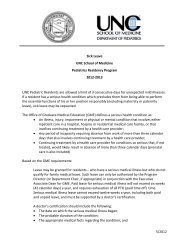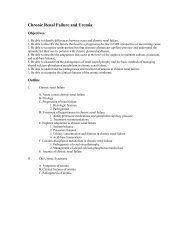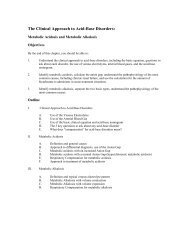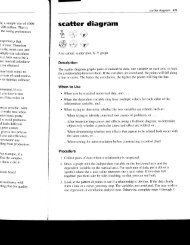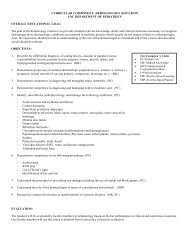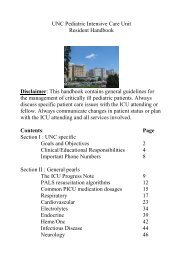Acute Renal Failure
Acute Renal Failure
Acute Renal Failure
Create successful ePaper yourself
Turn your PDF publications into a flip-book with our unique Google optimized e-Paper software.
<strong>Acute</strong> <strong>Renal</strong> <strong>Failure</strong><br />
Objectives<br />
By the end of this session you should be able to:<br />
* List the three major etiologic categories of acute renal failure.<br />
* List the major causes of each of the three major categories of acute renal failure.<br />
* Be aware of the basic findings in the urine that suggests the etiology of a patient's renal compromise.<br />
* Be aware of the information provided by urine electrolytes and urine osmolality.<br />
* Be able to calculate FE Na and understand what the results of this calculation indicate.<br />
* Cite the value, if any, of radiographic procedures such as intravenous pyelograms, ultrasound, and CT<br />
scans.<br />
* Cite the major causes of post-ischemic and nephrotoxic acute renal failure and be aware of the ways in<br />
which it differs from pre-renal and post-renal causes of acute renal failure.<br />
* Delineate the basic approach to managing patients with acute renal failure.<br />
* Cite the most common complications that may need to be addressed in patients with acute renal failure.<br />
* Diagnose the cause of a patient's renal failure and treat it appropriately depending on that etiology.<br />
* List some of the more common medications that cause nephrotoxic acute renal failure.<br />
* List the indications for dialysis in a patient in acute renal failure.
Outline<br />
I. Introduction<br />
II. Etiology of <strong>Acute</strong> <strong>Renal</strong> <strong>Failure</strong><br />
III. Pathophysiology of <strong>Acute</strong> <strong>Renal</strong> <strong>Failure</strong><br />
Pre-renal <strong>Acute</strong> <strong>Renal</strong> <strong>Failure</strong><br />
Intra-renal <strong>Acute</strong> <strong>Renal</strong> <strong>Failure</strong><br />
Glomerular Disease<br />
Post-ischemic and Nephrotoxic <strong>Acute</strong> <strong>Renal</strong> <strong>Failure</strong><br />
Interstitial Disease<br />
Post-renal <strong>Acute</strong> <strong>Renal</strong> <strong>Failure</strong><br />
IV. Diagnosis of <strong>Acute</strong> <strong>Renal</strong> <strong>Failure</strong><br />
History and Physical Findings<br />
Laboratory Testing<br />
Examination of the Urine<br />
Dipstick findings<br />
Microscopic findings<br />
Serum and Urine Chemical Analysis<br />
Creatinine and urea nitrogen<br />
Urine osmolality<br />
Urine sodium concentration<br />
Other indicies<br />
Radiographic Procedures<br />
V. Specific Diseases Causing <strong>Acute</strong> <strong>Renal</strong> <strong>Failure</strong><br />
Pre-renal disease<br />
Pre-renal azotemia caused by volume depletion<br />
Pre-renal azotemia caused by advanced liver disease<br />
Pre-renal azotemia caused by congestive heart failure<br />
Post-ischemic and Nephrotoxic <strong>Acute</strong> <strong>Renal</strong> <strong>Failure</strong><br />
Initial phase<br />
Maintenance phase<br />
Recovery phase<br />
Post-renal disease<br />
VI. Complications of <strong>Acute</strong> <strong>Renal</strong> <strong>Failure</strong><br />
Cardiovascular system<br />
Pulmonary system<br />
Gastrointestinal system<br />
Neurologic system<br />
Infectious complications<br />
Endocrine system<br />
Electrolyte metabolism<br />
VII. Treatment of <strong>Acute</strong> <strong>Renal</strong> <strong>Failure</strong><br />
Diuretics<br />
Diet<br />
Dialysis
I. INTRODUCTION<br />
<strong>Acute</strong> renal failure (ARF) is the generic term used to define an abrupt decrease in renal function<br />
sufficient to result in retention of nitrogenous waste (urea nitrogen and creatinine) in the body. The<br />
hallmark of ARF is progressive azotemia caused by the accumulation of the nitrogenous end-products of<br />
metabolism. This accumulation is accompanied by a wide range of other disturbances depending on the<br />
severity and duration of the renal dysfunction. These include metabolic derangements such as metabolic<br />
acidosis and hyperkalemia, disturbances of body fluid balance, and effects on many other organ systems.<br />
Table 1<br />
ARF - Incidence<br />
• Community acquired<br />
– 1% of hospital admissions<br />
• pre-renal ARF (70%), intra-renal (11%), post-renal<br />
(17%). Overall mortality 15%<br />
• Hospital acquired<br />
– 5% of hospitalized patients; 30% in ICU<br />
• decreased renal perfusion, postoperative renal<br />
insufficiency (60%), nephrotoxic agents (20%).<br />
Overall mortality 45%; Mortality due to ARF 27%<br />
ARF is commonly encountered in the<br />
practice of medicine, and 5% of hospital<br />
admissions to a general medical/surgical ward will<br />
go on to develop ARF. This disorder is less<br />
common in children than adults. Abrupt renal<br />
decline and failure is a final common pathway for a<br />
number of disease processes and is associated with<br />
significant morbidity and mortality (Table 1).<br />
II. ETIOLOGY OF ACUTE RENAL FAILURE<br />
Table 2<br />
ARF - Etiology<br />
• Pre-renal ARF: ↓ renal blood flow<br />
– Absolute volume depletion<br />
– Functional volume depletion<br />
• Intra-renal ARF: renal parenchymal disease<br />
– Glomerular disease<br />
– Tubulo -interstitial disease<br />
• Post-renal ARF: Urinary obstruction<br />
The various causes of ARF can be grouped into<br />
three major categories (Table 2):<br />
• those that decrease renal blood flow (prerenal)<br />
• those that produce a renal parenchymal insult<br />
(intra-renal)<br />
• those that obstruct urine flow (post-renal or<br />
obstructive).<br />
Identification of either a pre-renal or post-renal cause of ARF makes the initiation of a specific therapy<br />
possible. If, however, these two categories can be ruled out, then an intra-renal cause can be implicated.<br />
The renal parenchymal causes of ARF are usually subdivided into those primarily affecting the glomeruli<br />
or the renal interstitium. The term acute tubular necrosis denotes another broad category of intrinsic renal<br />
failure characterized by renal tubular injury that cannot be attributed to glomerular, vascular, or interstitial<br />
causes. The complete list of the most common causes of acute renal failure is noted in Table 3.
Table 3<br />
Causes of <strong>Acute</strong> <strong>Renal</strong> <strong>Failure</strong><br />
Pre-renal <strong>Acute</strong> <strong>Renal</strong> <strong>Failure</strong><br />
Absolute volume depletion<br />
Functional volume depletion<br />
Advanced liver disease<br />
Congestive heart failure<br />
Pharmacologic agents<br />
Angiotensin converting agents<br />
Non-steroidal anti-inflammatory agents<br />
Diseases of the <strong>Renal</strong> Vasculature<br />
<strong>Renal</strong> Artery Occlusion<br />
Thromboemboli<br />
Thrombosis<br />
Dissecting aortic aneurysm<br />
<strong>Renal</strong> artery stenosis<br />
<strong>Renal</strong> vein thrombosis<br />
Dehydration (infants)<br />
Diseases of the <strong>Renal</strong> Cortex<br />
Bilateral Cortical Necrosis<br />
Obstetrical accidents<br />
Abruptio placentas<br />
Placentas previa<br />
Gram-negative septicemia<br />
Ischemia<br />
Hyperacute renal allograft rejection<br />
Diseases of the <strong>Renal</strong> Medulla<br />
Bilateral Papillary Necrosis<br />
Analgesic abuse<br />
Sickle cell disease<br />
Diabetes mellitus<br />
<strong>Acute</strong> Tubulointerstitial Diseases<br />
<strong>Acute</strong> pyelonephritis<br />
<strong>Acute</strong> allergic interstitial nephritis<br />
Hypokalemic nephropathy<br />
Hypercalcemia<br />
<strong>Acute</strong> uric acid nephropathy<br />
Multiple myeloma<br />
<strong>Acute</strong> Glomerular Diseases<br />
<strong>Acute</strong> Glomerulonephritis<br />
Postinfectious glomerulonephritis<br />
Bacterial endocarditis<br />
Henoch-Schonlein Purpura<br />
Hypersensitivity angiitis<br />
Rapidly Progressive Glomerulonephritis<br />
Systemic lupus erythematosis<br />
Wegener’s Granulomatosis<br />
Goodpasture’s syndrome<br />
Thrombotic Microangiopathy<br />
Hemolytic-uremic Syndrome<br />
Thrombotic Thrombocytopenic Purpura<br />
Scleroderma<br />
Malignant Hypertension<br />
Postischemic <strong>Acute</strong> <strong>Renal</strong> <strong>Failure</strong><br />
Nephrotoxic <strong>Acute</strong> <strong>Renal</strong> <strong>Failure</strong><br />
Urinary Obstruction<br />
Intrarenal abnormalities<br />
Ureteral obstruction<br />
Diseases of bladder or urethra
III. PATHOPHYSIOLOGY OF ACUTE RENAL FAILURE<br />
Table 4<br />
Pre-<strong>Renal</strong> ARF<br />
• Decrease in renal blood flow<br />
• Glomerular filtration rate reduced<br />
– Inability to excrete nitrogenous waste<br />
• Kidney retains water and sodium<br />
– Concentrated urine (500 mOsm/L)<br />
– Oliguria (
Figure 1 shows the typical changes including<br />
dilated tubules and interstitial edema.<br />
Figure 1<br />
Figure 1<br />
Table 7<br />
ARF: Interstitial Disease<br />
• An inflammatory process is initiated in the renal<br />
interstitium<br />
• Etiology<br />
–Drugs<br />
–Toxic<br />
– Infectious<br />
– Infiltrative<br />
c) Interstitial Disease (Table 7):<br />
Interstitial nephritis is a complex collection of<br />
disease processes with a poorly understood<br />
pathophysiology. An inflammatory process is<br />
initiated in the renal interstitium in response to a<br />
wide variety of stimuli (toxic, metabolic,<br />
infectious, immune, infiltrative), although drugs<br />
are probably the most common causes.<br />
Pathophysiology of Post-renal <strong>Acute</strong> <strong>Renal</strong> <strong>Failure</strong>:<br />
Obstruction of the urinary tract leads to an<br />
acute rise in intratubular pressure. As a result, there is<br />
stimulation of the renin-angiotensin II system that results<br />
in marked renal vasoconstriction. The vasoconstriction<br />
then leads to a fall in the glomerular filtration rate and<br />
acute renal failure (Figure 2).<br />
Figure 2<br />
Urinary Tract Obstruction<br />
Intratubular pressure<br />
Glomerular capillary pressure<br />
<strong>Renal</strong> Vascular resistance<br />
Glomerular filtration rate<br />
3 Hours 24 Hours<br />
Figure 3<br />
Differential Diagnosis of <strong>Acute</strong> <strong>Renal</strong> <strong>Failure</strong><br />
Pre-<strong>Renal</strong> ARF ARF<br />
Post-Ischemic ARF ARF<br />
(50% of of cases)<br />
<strong>Acute</strong> <strong>Renal</strong> <strong>Failure</strong><br />
Intrinsic ARF ARF<br />
Post-<strong>Renal</strong> ARF ARF<br />
<strong>Acute</strong> Glomerulonephritis<br />
<strong>Acute</strong><br />
(5% (5% of of cases) Tubular Necrosis<br />
<strong>Acute</strong> Interstitial Nephritis<br />
(10% of of cases)<br />
Nephrotoxic ARF ARF<br />
(35% of of cases)<br />
IV. DIAGNOSIS OF ACUTE RENAL<br />
FAILURE<br />
Obviously, there is a large range of medical<br />
conditions that can result in ARF (Figure 3). Given<br />
this broad range of conditions and their differing<br />
therapeutic implications, it is important to rapidly<br />
establish an accurate diagnosis.<br />
A. History and physical exam<br />
Evaluation of the medical history, physical exam findings, and the results of a few radiographic studies<br />
are often necessary to determine the cause of acute renal failure. The initial history should include a review<br />
of the patient’s outpatient record, or in the case of an inpatient, a review of the inpatient record. History<br />
taking should always include certain questions or considerations:
• has nausea, vomiting, and/or diarrhea been present?<br />
• has bleeding occurred?<br />
• does the patient have a history of heart failure or recent symptoms of dyspnea?<br />
• does the patient have a history of chronic liver disease, hepatitis, or jaundice?<br />
• does the patient have a history of previous renal insufficiency?<br />
• has edema, high blood pressure, or a change in urine color occurred?<br />
• has the patient had any unusual rashes develop recently?<br />
• what medications has the patient been placed on, in particular, are there any new medications?<br />
• has the patient been ill enough to have prolonged episodes of hypotension?<br />
• has the patient received any contrast dyes?<br />
• does the patient have a history of renal stone disease or evidence or lower urinary tract obstruction?<br />
Often, the history alone can suggest the cause as being pre-renal, renal, or post-renal. Physical exam is<br />
usually most helpful in assessing the volume status of a patient. Both the total volume and the effective<br />
circulating volume must be considered. Clues for the presence of a systemic disease (ex. vasculitis, CHF,<br />
liver disease) should be sought. Despite a careful history and physical exam, the etiology of ARF often<br />
remains unclear and additional tests must be done.<br />
B. Laboratory testing to help with diagnosis<br />
1. Examination of the Urine: Urinalysis is one of the first, and easiest, tests that can be done on the<br />
patient with acute renal failure. It can provide both diagnostic information as well as prognostic<br />
information about the patient. Hou et al. found that about one-half of 97 patients with ARF had an<br />
abnormal microscopic urinalysis. This abnormal microscopic exam was associated with a "renal" cause of<br />
ARF and a 35% mortality, while those with a normal urinalysis had a 15% mortality.<br />
a. Dipstick Findings: A dipstick positive for protein (3+, 4+) suggests intrinsic renal disease with<br />
glomerular damage. Pre-renal azotemia, obstruction, and acute tubular necrosis tend to be associated with<br />
less proteinuria (trace-2+) than a glomerular lesion. If there is proteinuria present it should be quantified<br />
using a 24-hour urine collection. If there is greater than 3 gm of protein, a glomerular, rather than a tubular<br />
or interstitial, process is more likely. A dipstick positive for blood indicates the presence of RBC's (><br />
5/HPF). If no RBC's are present, then there may be either myoglobin or hemoglobin present in the urine.<br />
b. Microscopic Examination Findings: In most cases the most significant amount of information is<br />
obtained from the urinalysis comes from the examination of the sediment of a centrifuged urine sample.<br />
This is prepared by placing 10 cc of urine in a conical tube and spinning at 2000 rpm for 5 minutes. The<br />
supernatant is discarded. The sediment is then resuspended in the residual urine, and a drop is placed on a<br />
slide and covered with a cover slip. The periphery of the slide, where casts tend to be concentrated, is<br />
scanned using low power. The slide is then scanned under high power for red blood cells, white cells, renal<br />
tubular epithelial cells, oval fat bodies, bacteria, and crystals.<br />
Casts are formed from urinary Tamm-Horsfall protein, which is a product of the tubular epithelial cells.<br />
This protein tends to gel in conditions of high concentration and when mixed with red cells, tubular cells,<br />
or cellular debris. Thus, the composition of this cast reflects the contents of the tubule.<br />
Hyaline casts (http://medstat.med.utah.edu/WebPath/jpeg2/URIN069.jpg) are those that are<br />
devoid of contents, and are seen with dehydration, or after exercise.<br />
Red cell casts (http://www.hsc.virginia.edu/med-ed/cell/resources/images/UrinaryFig7.jpg)<br />
indicate glomerular hematuria, as seen with glomerulonephritis.<br />
White cell casts (http://medlib.med.utah.edu/WebPath/jpeg2/URINE071.jpg)<br />
imply the presence of renal parenchymal inflammation.
Granular casts are composed of cellular remnants and debris, and are generally a non-specific<br />
indicator of renal parenchymal injury. Granular casts that are deeply pigmented, often referred to as<br />
“muddy brown casts,” (http://www.udel.edu/medtech/mclane/ua11a.jpg), however, are a<br />
fairly specific finding in acute tubular injury (nephrotoxic or ischemic “ATN”).<br />
.<br />
Fatty casts (http://www.lhsc.on.ca/lab/renal/images/slide10.jpg) are usually<br />
associated with heavy proteinuria and the nephrotic syndrome (though they can be present in other<br />
nonglomerular disease).<br />
In patients with pre-renal azotemia, the sediment usually lacks cells, casts, and cellular debris. Similarly,<br />
postrenal causes of ARF tend to be associated with a benign sediment. The presence of dysmorphic RBC's<br />
and red cell casts is characteristic of a glomerular lesion. WBC's and white cell casts are seen in acute<br />
interstitial nephritis. The finding of eosinophils in a Hansel’s-stained urine sediment has been suggested as<br />
indicating a drug-induced acute interstitial nephritis (this is not a specific finding as eosinophils can be<br />
present in other disease states).<br />
2. Serum and Urine Chemical Analysis:<br />
a. Creatinine and BUN: Creatinine is formed from the breakdown of muscle creatinine and is<br />
proportional to the muscle mass. It should be stable from day to day. The creatinine concentration is a<br />
function of the amount of creatinine entering the blood from muscle, its volume of distribution, and its rate<br />
of excretion. Since the first two are usually constant, and changes in the serum creatinine level would<br />
usually be a result of a change in the GFR. Abrupt cessation of glomerular filtration causes the serum<br />
creatinine to rise by 1-2 mg/dL daily. The BUN also rises with renal dysfunction but is influenced by<br />
extrarenal factors as well. Increased protein intake, catabolism, GI bleeding, and many other factor will<br />
effect BUN.<br />
The two important points to remember about elevations of serum creatinine and BUN are: First,<br />
they are late signs of renal dysfunction because the GFR may need to be reduced by as much as 75% before<br />
the BUN and creatinine rise to abnormal levels. Second, many non-renal variables affect both these levels.<br />
Generally, a serum BUN to creatinine ratio of greater than 20 suggests pre-renal azotemia rather than ATN,<br />
which is associated with a ratio of 10 to 1.<br />
b. Urine Osmolality: Normally, the kidney can concentrate urine to levels of approximately 1,200<br />
mOsm/kg. The ability to do this depends on an intact tubular system. Urine osmolality levels greater than<br />
500 mOsm/kg suggest pre-renal azotemia (Table 8). By comparison, extensive tubular damage, such as that<br />
seen in ATN, impairs the ability of the kidney to generate a concentrated urine. Typically, the urine<br />
osmolality in ATN approximates that of the serum (300-350 mOsm/kg).<br />
Table 8<br />
Tests useful in the diagnosis of acute renal failure due to pre-renal<br />
causes<br />
Urine sodium less than 20 mEq/L<br />
Urine osmolality greater than plasma osmolality<br />
BUN-to-serum creatinine ratio greater than 20<br />
Urine osmolality greater than 500 mOsm/kg<br />
Fractional sodium excretion less than 1%<br />
Diagnostic ultrasound shows normal sized<br />
kidneys
Table 9<br />
ATN versus Pre-renal Azotemia<br />
Indices Prerenal ATN<br />
UNa < 20 mEq/L > 40 mEq/L<br />
FeNA < 1% > 4%<br />
U/PCreat > 40 < 20<br />
Uosm > 500 mOsm/kg 300-350 mOsm/kg<br />
c. Urine Sodium Concentration: Urine sodium<br />
excretion reflects how well the nephron retains the<br />
filtered sodium load. With renal hypo-perfusion<br />
due to either volume depletion or ineffective<br />
circulating blood volume, the kidney will avidly<br />
retain sodium as a result of increased proximal<br />
and distal reabsorption. If the kidney is<br />
responding appropriately to a decreased effective<br />
intravascular volume, the urine sodium<br />
concentration will usually be low (less than 20<br />
mEq/L) and the fractional excretion of sodium<br />
(FE Na ) will be < 1%. The average FE Na has been<br />
reported to be > 4.0% in patients with<br />
postischemic or nephrotoxic ARF (Table 9).<br />
d. Other Indices: There are multiple other indices than can be measured when trying to evaluate renal<br />
failure. These include Urine/Serum Creatinine Ratio, <strong>Renal</strong> <strong>Failure</strong> Index, Urine/Serum Urea Ratio,<br />
creatinine clearance, and Free Water Clearance. None of these tests have advantages in diagnosis over the<br />
FE Na .<br />
Ischemic and<br />
Nephrotoxic<br />
Tubular Injury<br />
Interstitial<br />
Nephritis<br />
Glomerulonephritis<br />
Table 10<br />
Urinary Findings in Intra-renal ARF<br />
Protein<br />
Mild to<br />
moderate<br />
Mild to<br />
moderate<br />
Moderate to<br />
heavy<br />
Urine sediment<br />
“Muddy<br />
brown”<br />
granular casts<br />
WBC casts<br />
Eosinophiluria<br />
RBC casts<br />
Urine<br />
Chemistries<br />
Uosm 300-350<br />
mOsm/kg<br />
FENa+ > 4%<br />
Uosm 300-350<br />
mOsm/kg<br />
FENa+ > 4%<br />
Uosm > 500<br />
mOsm/kg<br />
FENa+ < 1 %<br />
The urinary and serum indices help to<br />
distinguish pre-renal from intrinsic causes of ARF<br />
(Tables 10 &11). However, several points should<br />
be remembered. In diseases that affect the renal<br />
glomerulus primarily, such as acute<br />
glomerulonephritis, the urinary and serum indices<br />
will more closely resemble those of pre-renal<br />
azotemia rather than intrinsic renal disease. Post<br />
renal causes of ARF can also be associated with<br />
indices similar to those of pre-renal azotemia early<br />
in the course of obstruction. With continued<br />
obstruction, tubular function becomes impaired<br />
and the indices mimic those of intrinsic disease.<br />
Table 11<br />
Urinary Findings in Pre-renal and Post-renal ARF<br />
Protein<br />
Urine<br />
Sediment<br />
Urine<br />
Chemistries<br />
Pre-renal<br />
None to trace<br />
Normal or<br />
hyaline casts<br />
Uosm > 500<br />
mOsm/kg<br />
FENa+ < 1%<br />
Post-renal<br />
None to trace<br />
Crystals, red or<br />
white cell casts<br />
Variable
3. Radiographic Procedures<br />
a. Intravenous Pyelogram: IVP provides an anatomic picture of the kidney but does not help evaluate<br />
kidney function. It also subjects the patient to a dye load. This can potentially be harmful to kidneys that<br />
may have already had previous insult. At this time there is little indication for IVP in the patient with acute<br />
renal failure.<br />
b. Ultrasonography: <strong>Renal</strong> ultrasound is the most valuable diagnostic technique for the assessment of the<br />
patient with ARF. It can be performed easily in the patient with impaired renal function and has no<br />
associated morbidity. It is a sensitive test for obstruction (93-98%) and provides information about kidney<br />
size (the kidney size can be helpful in judging the chronicity of the kidney disease).<br />
c. Computed tomography (CT): This can be helpful in some patients. Hydronephrosis can be recognized<br />
without contrast. The cause of obstruction (Ex. lymphoma, retroperitoneal fibrosis, etc) can often be<br />
delineated. CT is the technique of choice for visualizing ureteral obstruction at the level of the bony pelvis.<br />
d. Other Tests: Radionuclide scans can be used if there is a concern about vascular perfusion of the<br />
kidneys. percutaneous nephrostomy combined with antegrade pyelography can be employed to diagnose<br />
the precise level of obstruction in the urinary tract. Ultimately, if the diagnosis is still unclear, the patient<br />
may need a renal biopsy.<br />
Table 12<br />
Diagnostic Evaluation of <strong>Renal</strong> <strong>Failure</strong><br />
• Assess volume status<br />
• Exclude urinary tract obstruction<br />
• Ascertain nephrotoxic exposures<br />
• Examine the urine sediment<br />
• Check urinary indices<br />
So How do I Make the Diagnosis (Table 12)?<br />
Start with the history and physical exam<br />
as already discussed. The general strategy is to rule<br />
out both pre-renal and postrenal causes before<br />
considering the many intrinsic reasons. First,<br />
sources of volume loss and causes of decreased<br />
cardiac output should be sought in the history. The<br />
patient should be questioned for bleeding sources,<br />
GI losses, evidence of CHF, or history of liver<br />
disease. In males, a history should be taken<br />
searching for evidence of prostatic disease. A<br />
documented history of anuria could imply highgrade<br />
obstruction, but this can accompany severe<br />
volume depletion, severe acute glomerulonephritis,<br />
cortical necrosis, or bilateral vascular occlusion. Intermittent anuria is more suggestive of obstructive<br />
disease.<br />
The patient should further be questioned about the use of all medications as well as recent<br />
exposure to contrast dyes. A history of recent pharyngitis, hypertension, rash, fever, or dark colored urine<br />
may suggest glomerulonephritis associated with a multisystem process.<br />
The physical exam should focus on signs of volume depletion or overload. An attempt to percuss<br />
the bladder should be made. If the dome of the bladder is felt, this implies that there is 500cc of urine<br />
present. Prostate exam in males and a pelvic exam in females are essential. The skin should be assessed for<br />
the presence of a rash.
Laboratory evaluation should start with a dipstick of the urine and then microscopic analysis. An<br />
attempt at quantification of urine output should be made. BUN, creatinine, urine electrolytes, and then<br />
FENa levels should be determined. Next, a CBC, serum electrolytes, calcium, phosphorus, magnesium<br />
should be done. A serum creatinine kinase should be obtained to evaluate for rhabdomyolysis when<br />
suspected, such as following multiple trauma or crush injuries. An ECG and chest x-ray may aid in the<br />
evaluation.<br />
Pre-renal azotemia should be suspected in the setting of volume loss, volume redistribution, or<br />
decreased effective renal perfusion. It is typically associated with a normal urinalysis, high BUN/Creat<br />
ratio, increased urine osmolarity, urine sodium levels less than 20 mEq/L, and a FE Na less than 1%.<br />
Urethral or bladder neck obstruction is documented by the finding of significant amounts of<br />
residual urine in the bladder on catheterization after the patient attempts to void spontaneously. Urine<br />
indices in obstruction may not be helpful, although the BUN/creat ratio may be elevated. Since obstruction<br />
is a reversible cause of renal failure, an ultrasound should always be obtained early in the evaluation.<br />
Finally, the presence of a renal parenchymal disorder can often be diagnosed by its manifestations<br />
on microscopic urinalysis, by associated extrarenal manifestations, or by the clinical setting of recent<br />
exposure to a new medication. In the absence of these clues, the failure to find evidence of pre-renal or<br />
postrenal disease may be taken as presumptive evidence of an intrarenal parenchymal process. The<br />
possibility of a vascular insult should always be kept in mind since timely intervention is critical to<br />
preserving renal function.<br />
V. SPECIFIC DISEASES CAUSING ACUTE RENAL FAILURE<br />
1. Pre-renal Disease<br />
A reduction in renal blood flow is the most common cause of acute renal failure. This can occur from<br />
true volume depletion or from selective renal ischemia (as in bilateral renal artery stenosis or sepsis). The<br />
usual causes of pre-renal azotemia are true volume depletion, or a decrease in the effective circulating<br />
blood volume as occurs in sepsis, advanced liver disease, and congestive heart failure.<br />
a. Pre-renal Azotemia Caused by True Volume Depletion: The cause of volume depletion is usually<br />
evident from the history and exam. In severe cases the patient may be in hypovolemic shock. Oliguria is<br />
present in most individuals and this is an appropriate response given the clinical situation. Normal or<br />
increased urine output indicates that an osmotic agent or other diuretic agent is acting, or that there is<br />
tubular dysfunction such as ATN.<br />
b. Pre-renal Azotemia Caused by Sepsis: The mechanisms by which sepsis leads to decreased renal<br />
perfusion are incompletely understood. Decreased renal blood flow independent from the effects of<br />
systemic hypotension has been demonstrated. Factors that may contribute to such include altered<br />
autonomic regulation of renal blood flow as well as cytokine-induced renal vasoconstriction.<br />
c. Pre-renal Azotemia Caused by Advanced Liver Disease: Liver disease is associated with two major<br />
changes in renal function: sodium retention, initially manifested as ascites, and a progressive decline in<br />
GFR. Both humoral and hemodynamic factors play a primary role in the development of these problems.<br />
The progressive decline in renal function that occurs in hepatic cirrhosis is thought to be hemodynamically<br />
mediated because tubular function is intact (as evidenced by low urine sodium concentration and a normal<br />
urinalysis) and the kidneys are histologically intact.<br />
d. Pre-renal Azotemia Caused by Congestive Heart <strong>Failure</strong>: CHF is associated with two major<br />
alterations in renal function: sodium retention early in the course of the disease and a decline in GFR as<br />
cardiac function worsens. Neurohumoral factors and certain therapies may contribute to these problems.
2. <strong>Acute</strong> Tubular Necrosis:<br />
The characteristic tubular injury in this disorder represents a nonspecific response that can be seen with a<br />
variety of renal insults, including renal ischemia and exposure to exogenous or endogenous nephrotoxins<br />
(see table 13). The net effect is a rapid decline in renal function that may require a period of dialysis before<br />
spontaneous resolution occurs. There are two major histologic changes that take place in ATN: (1) tubular<br />
necrosis with sloughing of the epithelial cells; and (2) occlusion of the tubular lumina by casts and by<br />
cellular debris. These changes may be patchy and seem mild compared to the degree of the renal failure. In<br />
addition of the tubular obstruction, two other factors appear to contribute to the development of renal<br />
failure in ATN: backleak of filtrate across the damaged tubular epithelia and a primary reduction in<br />
glomerular filtration. The decrease in glomerular filtration results both from arteriolar vasoconstriction and<br />
from mesangial contraction. The decline in renal function in ATN has a variable onset. It typically begins<br />
abruptly following a hypotensive episode, rhabdomyolysis, or the administration of a radiocontrast media.<br />
In comparison, when aminoglycosides are the cause, the onset is more insidious, with the first rise in<br />
creatinine being at seven or more days.
Table 13<br />
Major Causes of Nephrotoxic <strong>Acute</strong> <strong>Renal</strong> <strong>Failure</strong><br />
Antibacterial Agents<br />
• Aminoglycosides<br />
• Beta Lactam Antibiotics<br />
• Vancomycin<br />
• Sulfonamides<br />
Antiviral Agents<br />
• Acyclovir<br />
• Indinavir<br />
• Foscarnet<br />
Antifungal Agents<br />
• Amphotericin<br />
Antiprotozoal Agents<br />
• Pentamidine<br />
Chemotherapeutic Agents<br />
Alkylating Agents<br />
• Cisplatinum<br />
Antimetabolites<br />
• Methotrexate<br />
Antitumor Antibiotics<br />
• Mitomycin<br />
Immunotherapeutic Agents<br />
• Interleukin-2<br />
• Interferon<br />
Immunosuppressive Agents<br />
• Cyclosporine<br />
• Tacrolimus<br />
Nonsteroidal Anti-inflammatory Drugs<br />
Radiocontrast agents<br />
Environmental and Occupational Agents<br />
• Organic Solvents<br />
• Ethylene Glycol<br />
• Heavy Metals<br />
• Mercury<br />
• Pesticides, Insecticides, Herbicides and<br />
Fungicides<br />
• Chlordane, Paraquat<br />
Biologicals<br />
• Mycotoxins<br />
• Ochratoxin A<br />
• Venoms<br />
• Mushrooms<br />
Osmotic Agents<br />
• Sucrose<br />
• Mannitol<br />
Heme Pigments<br />
• Hemoglobin<br />
• Myoglobin<br />
Uric Acid<br />
VI. COMPLICATIONS OF RENAL FAILURE<br />
1. Cardiovascular System:<br />
Complications of the cardiovascular system are common in ARF. In a study with 462 patients with ATN,<br />
cardiovascular complications (congestive heart failure, myocardial infarction, and cardiac arrest) occurred<br />
in 35% of cases. In the oliguric patient with ARF, volume overload with hypertension, edema, and<br />
pulmonary congestion is an ever-present threat. Pericarditis may rarely complicate the course of ARF, and<br />
may lead to pericardial tamponade and life-threatening cardiovascular compromise.<br />
2. Pulmonary System Complications:<br />
Pulmonary infiltrates due to edema from volume overload and/or infection are encountered frequently in<br />
ARF. Remember that there are several disease processes that can cause simultaneous pulmonary and renal<br />
involvement. These include glomerulonephritis, Goodpasture’s, SLE, Wegener's, polyarteritis, sarcoidosis,<br />
renal vein thrombosis with pulmonary embolism, and several others. The development of pulmonary<br />
complications in ARF is an adverse prognostic factor.
3. Gastrointestinal System Complications:<br />
The most common GI manifestations of ARF are severe nausea, vomiting, and anorexia. Upper GI<br />
bleeding is another significant complication. Stress ulcers and gastritis are common.<br />
4. Neurologic System Complications:<br />
CNS disorders are frequent accompaniments of ARF. Initially, lethargy, somnolence, lassitude, and<br />
fatigue are present. These symptoms may progress to irritability, confusion, disorientation, decreased<br />
memory, twitching, asterixis, and myoclonus. In advanced cases, generalized seizures may occur with<br />
somnolence and coma. The encephalopathy of ARF has not yet been firmly identified as a complication of<br />
a single specific identifiable toxin. Thus, the pathophysiology of neurologic complications of ARF remains<br />
unclear. One thing to consider is whether the CNS disturbance may in fact be coming from the medications<br />
the patient is on in the face of ARF.<br />
5. Infectious Complications:<br />
ARF and infections are commonly associated. Not only is septicemia frequently associated with the onset<br />
of ARF, but also infections often complicate the course of ARF. Common foci include pulmonary, urinary,<br />
and central venous catheter related bacteremia. These infectious complications can be a leading source of<br />
morbidity and mortality.<br />
6. Endocrine System Complications:<br />
Several hormonal abnormalities have been described in ARF. For, example, ATN is often associated with<br />
disturbances in divalent ion metabolism (hypocalcemia, hyperphosphatemia, and hypermagnesemia).<br />
Altered PTH action and vitamin D metabolism may play a pathogenic role in the hypocalcemia and<br />
hyperphosphatemia. Several studies have demonstrated high PTH levels in ATN, which may occur in<br />
response to the low calcium levels. Thyroid function tests may show decreased levels of Total T4 and T3,<br />
but the patients are usually euthyroid. High plasma renin activity and angiotensin II levels often occur in<br />
the setting of ARF. Whether these factors contribute to the hypertension has yet to be determined.<br />
7. Disorders of Electrolyte Metabolism:<br />
Hyperkalemia, hyponatremia, metabolic acidosis, and hypocalcemia often occur in ARF. These<br />
abnormalities should be expected and searched for so that the appropriate treatment can be initiated.<br />
Certain other disease entities being present can significantly worsen these levels (such as rhabdomyolysis).<br />
Hyperphosphatemia can also be expected, because of the decreased renal excretion of phosphate. In cases<br />
of coexisting tissue damage this could be worse.<br />
VII. TREATMENT OF ACUTE RENAL FAILURE<br />
The patient with acute renal failure may present extremely ill and sometimes moribund. There is almost<br />
no margin for error and the differential diagnosis can be extremely difficult. In spite of this, it is necessary<br />
to take a strict logical approach to the patient. First, resuscitate, next search for the correct diagnosis and<br />
treat accordingly, and finally prevent complications through the use of supportive measures and dialysis<br />
(Table 14).<br />
Resuscitation: The two most common causes of death early in the resuscitative phase are hyperkalemia and<br />
pulmonary edema. Over hydration with resultant pulmonary edema is usually iatrogenic as a result of futile<br />
attempts to restore urine output before the etiology of the renal failure has been established.
Post-renal <strong>Failure</strong>: In those with postrenal failure, a passage for the drainage of urine must be created. The<br />
exact method that is used will depend entirely on the level of the obstruction and may be as simple as a<br />
urinary catheter, or as complex as a percutaneous nephrostomy tube.<br />
Pre-renal <strong>Failure</strong>: Treatment for True Volume Depletion: Therapy for this type of ARF is aimed at<br />
restoration of the normal circulating blood volume. The major question that needs to be addressed is the<br />
rate at which the fluid should be given. This usually depends on the clinical status of the patient. Initially<br />
fluid boluses may be needed, and if indicated blood transfusion may be required. The patient must be<br />
constantly reassessed to insure that the patient is not getting overhydrated. The adequacy of fluid repletion<br />
can be assessed from physical exam and by monitoring renal function and urine output.<br />
Pre-renal <strong>Failure</strong>: Treatment for ARF due to Advanced Liver Disease: Dietary sodium restriction and<br />
periods of bed rest are the mainstays of nonmedical therapy in this disease entity. Medical therapies are as<br />
follows. Diuretics therapy is often indicated and the preferred agent is spironolactone. Normally this is a<br />
fairly weak diuretic, however in cases of liver failure it is very effective. Spironolactone is the only diuretic<br />
that does not require secretion into the lumen of the kidney. Rather, it enters the collecting tubule cells<br />
from the blood side and competes for the aldosterone receptor. The rate of diuresis needs to be slow and<br />
steady. Paracentesis may be helpful in those patients with tense ascites. Albumin may be given at the same<br />
time to help prevent the worsening of intravascular depletion. A peritoneovenous shunt, which drains into<br />
the internal jugular vein and translocates the ascitic fluid into the vascular space may be helpful in cases of<br />
severe portal hypertension and ascites, but is often complicated by worsening hepatic encephalopathy.<br />
Pre-renal <strong>Failure</strong>: Treatment of ARF Caused by Congestive Heart <strong>Failure</strong>: The use of diuretics may be of<br />
some help as this will increase the renal output and relieve pulmonary congestion. Another option is a trial<br />
of inotropic agents to help increase cardiac output and thus increase renal perfusion. ACE inhibitors may<br />
also be helpful to improve cardiac output, but must be used with caution in patients with acute renal failure<br />
as they may cause a fall in GFR, particularly in patients with renal vascular disease.<br />
<strong>Renal</strong> Causes of ARF: When pre-renal and renal causes of ARF have been ruled out, the challenge<br />
becomes to identify the cause of the intrinsic renal failure, keeping in mind the multitude of known possible<br />
causes.
Most commonly, the cause of the intrinsic renal failure will be from ATN. Therapy in established ATN,<br />
other than correction of the underlying problem, is largely supportive. In particular, attention must be paid<br />
to maintenance of the fluid and electrolyte balance and to proper nutrition. Despite management, some<br />
patients will require dialysis. Indications for dialysis include:<br />
• marked fluid overload<br />
• severe hyperkalemia<br />
• presence of uremic signs or symptoms (pericarditis, nausea and vomiting, confusion, bleeding with<br />
coagulopathy present)<br />
• severe metabolic acidosis (controversial)<br />
• BUN levels greater than 100<br />
Table 14<br />
Summary of Therapy and Goals in the Initial Phase of <strong>Acute</strong> <strong>Renal</strong> <strong>Failure</strong><br />
Therapy<br />
Volume expansion/hydration<br />
Diuretics<br />
Vasoactive agents<br />
Dopamine<br />
Atrial natriuretic peptide<br />
Cytoprotective agents<br />
Free radical scavengers<br />
Xathine oxidase inhibitors<br />
Calcium channel blockers<br />
Prostaglandins<br />
Goal<br />
Prevention of injury<br />
Management of volume overload<br />
Restoration of renal perfusion<br />
Preservation of cell integrity<br />
The use of diuretics may be able to convert oliguric ATN into nonoliguric ATN. While nonoliguric ATN<br />
has a better prognosis than oliguric ATN this is only the case when it occurs spontaneously. Conversion of<br />
oliguric ARF to nonoliguric ARF by the use of diuretics does not improve the prognosis. Lasix is often<br />
used in high doses either by rapid infusion or by a continuous drip to help manage volume overload.<br />
Finally, dopamine may be an effective agent along with lasix in an effort to increase urine output but with<br />
no documented improvement in outcome.





